WHO Grant Proposal: Diabetes Type 2 Patient Health and Lifestyle Study
VerifiedAdded on 2020/05/04
|12
|3436
|137
Essay
AI Summary
This essay presents a research proposal for a study on Type 2 Diabetes Mellitus (T2DM), focusing on the perspectives of patients regarding their health issues and lifestyle management. The study, proposed for Australia, aims to explore the challenges faced by T2DM patients, their coping mechanisms, and the role of healthcare providers. It seeks to understand the emotional and practical difficulties associated with lifestyle changes, such as dietary restrictions, and the moral pressures patients experience. The research employs a qualitative approach using in-depth interviews with both patients and healthcare providers to gather data. The study addresses ethical considerations, including participant confidentiality and informed consent, and aims to provide insights for improving T2DM management strategies. The research questions include the types of lifestyle challenges, coping strategies, and pressures faced by patients, aiming to inform the development of more effective interventions and support systems. The study design includes purposive sampling of patients and healthcare providers, data collection through questionnaires and in-depth interviews, and data analysis using content analysis. The justification for a qualitative study is provided, highlighting its suitability for exploring the complex experiences of T2DM patients and their healthcare providers.
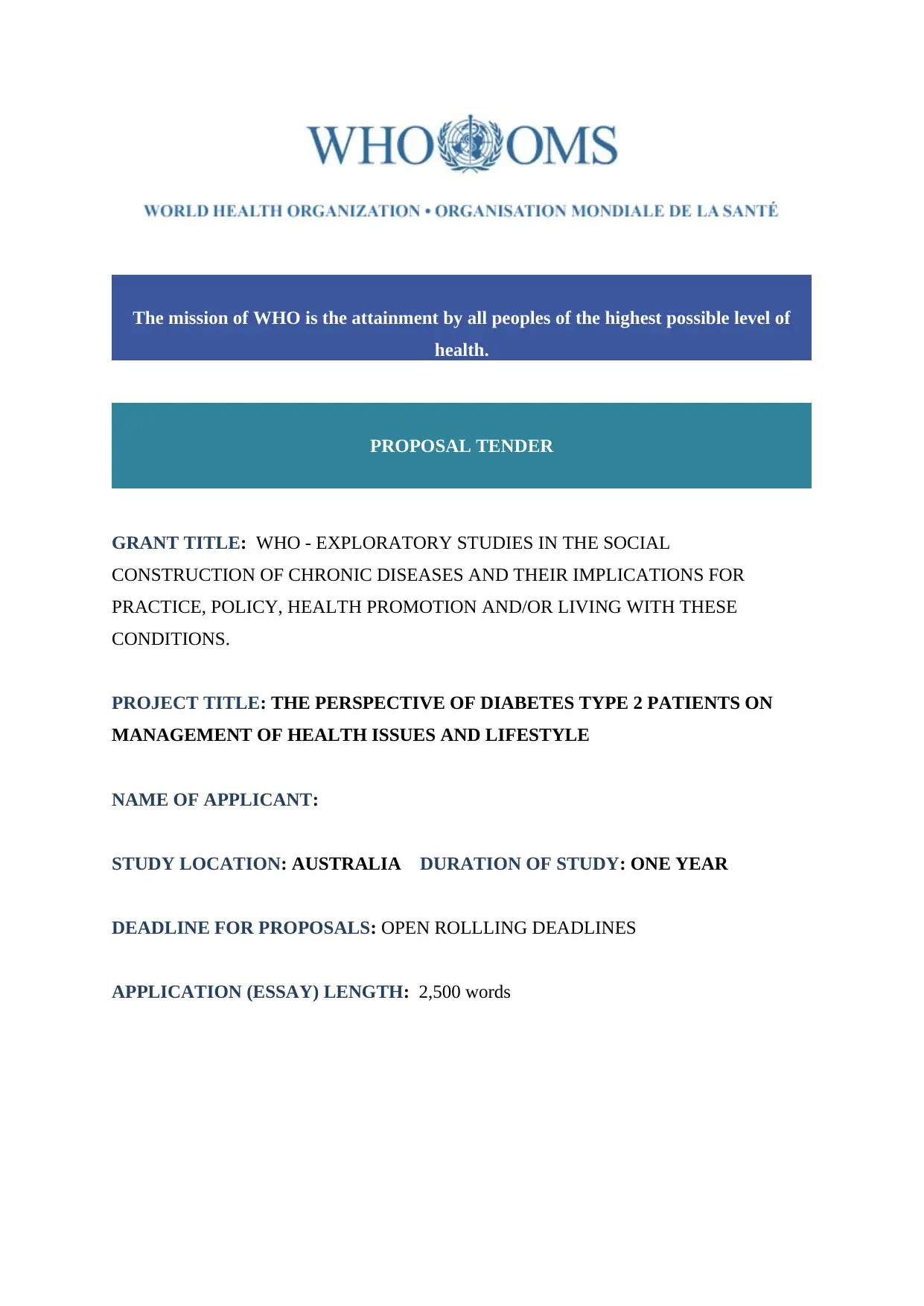
The mission of WHO is the attainment by all peoples of the highest possible level of
health.
PROPOSAL TENDER
GRANT TITLE: WHO - EXPLORATORY STUDIES IN THE SOCIAL
CONSTRUCTION OF CHRONIC DISEASES AND THEIR IMPLICATIONS FOR
PRACTICE, POLICY, HEALTH PROMOTION AND/OR LIVING WITH THESE
CONDITIONS.
PROJECT TITLE: THE PERSPECTIVE OF DIABETES TYPE 2 PATIENTS ON
MANAGEMENT OF HEALTH ISSUES AND LIFESTYLE
NAME OF APPLICANT:
STUDY LOCATION: AUSTRALIA DURATION OF STUDY: ONE YEAR
DEADLINE FOR PROPOSALS: OPEN ROLLLING DEADLINES
APPLICATION (ESSAY) LENGTH: 2,500 words
health.
PROPOSAL TENDER
GRANT TITLE: WHO - EXPLORATORY STUDIES IN THE SOCIAL
CONSTRUCTION OF CHRONIC DISEASES AND THEIR IMPLICATIONS FOR
PRACTICE, POLICY, HEALTH PROMOTION AND/OR LIVING WITH THESE
CONDITIONS.
PROJECT TITLE: THE PERSPECTIVE OF DIABETES TYPE 2 PATIENTS ON
MANAGEMENT OF HEALTH ISSUES AND LIFESTYLE
NAME OF APPLICANT:
STUDY LOCATION: AUSTRALIA DURATION OF STUDY: ONE YEAR
DEADLINE FOR PROPOSALS: OPEN ROLLLING DEADLINES
APPLICATION (ESSAY) LENGTH: 2,500 words
Paraphrase This Document
Need a fresh take? Get an instant paraphrase of this document with our AI Paraphraser
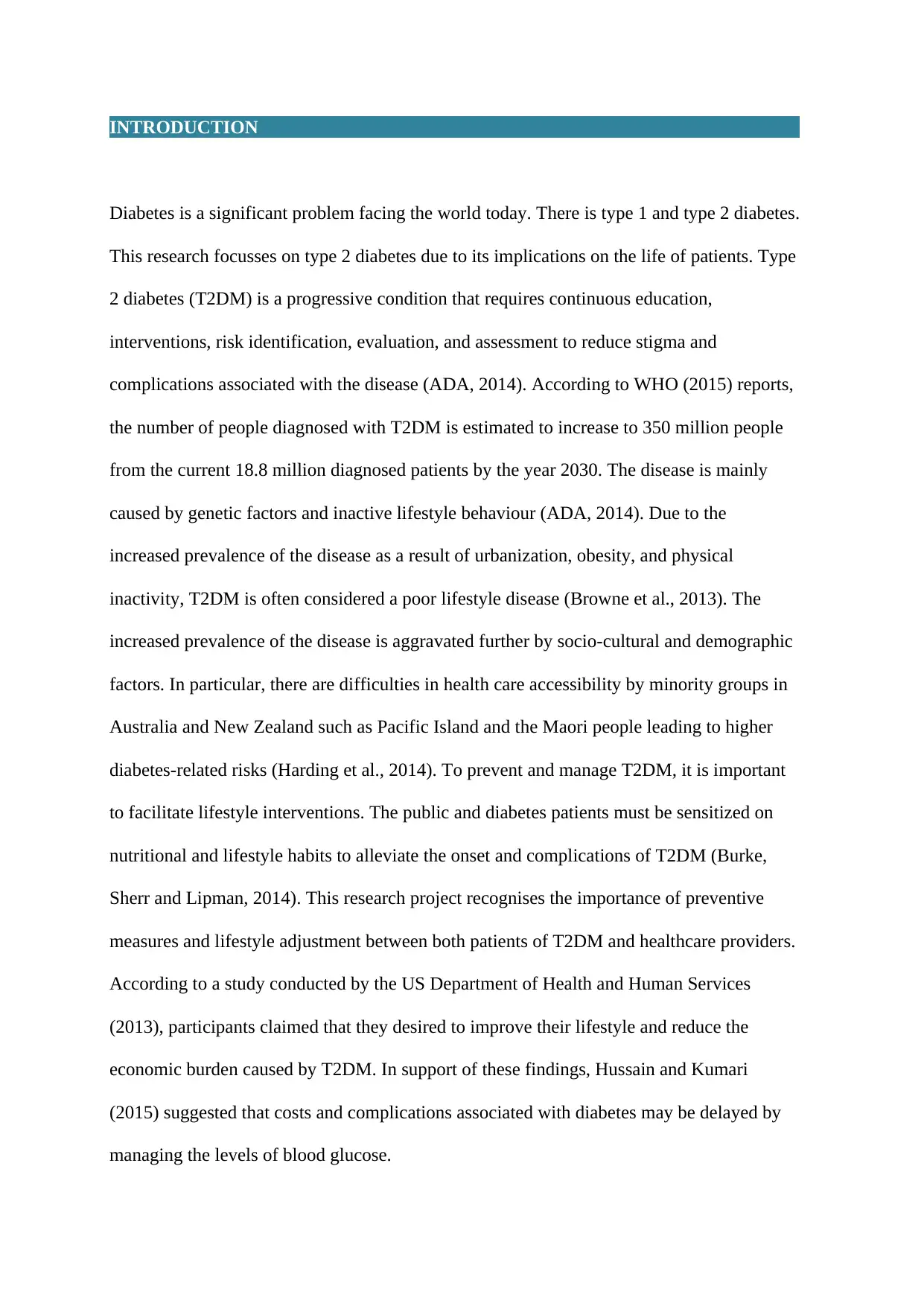
INTRODUCTION
Diabetes is a significant problem facing the world today. There is type 1 and type 2 diabetes.
This research focusses on type 2 diabetes due to its implications on the life of patients. Type
2 diabetes (T2DM) is a progressive condition that requires continuous education,
interventions, risk identification, evaluation, and assessment to reduce stigma and
complications associated with the disease (ADA, 2014). According to WHO (2015) reports,
the number of people diagnosed with T2DM is estimated to increase to 350 million people
from the current 18.8 million diagnosed patients by the year 2030. The disease is mainly
caused by genetic factors and inactive lifestyle behaviour (ADA, 2014). Due to the
increased prevalence of the disease as a result of urbanization, obesity, and physical
inactivity, T2DM is often considered a poor lifestyle disease (Browne et al., 2013). The
increased prevalence of the disease is aggravated further by socio-cultural and demographic
factors. In particular, there are difficulties in health care accessibility by minority groups in
Australia and New Zealand such as Pacific Island and the Maori people leading to higher
diabetes-related risks (Harding et al., 2014). To prevent and manage T2DM, it is important
to facilitate lifestyle interventions. The public and diabetes patients must be sensitized on
nutritional and lifestyle habits to alleviate the onset and complications of T2DM (Burke,
Sherr and Lipman, 2014). This research project recognises the importance of preventive
measures and lifestyle adjustment between both patients of T2DM and healthcare providers.
According to a study conducted by the US Department of Health and Human Services
(2013), participants claimed that they desired to improve their lifestyle and reduce the
economic burden caused by T2DM. In support of these findings, Hussain and Kumari
(2015) suggested that costs and complications associated with diabetes may be delayed by
managing the levels of blood glucose.
Diabetes is a significant problem facing the world today. There is type 1 and type 2 diabetes.
This research focusses on type 2 diabetes due to its implications on the life of patients. Type
2 diabetes (T2DM) is a progressive condition that requires continuous education,
interventions, risk identification, evaluation, and assessment to reduce stigma and
complications associated with the disease (ADA, 2014). According to WHO (2015) reports,
the number of people diagnosed with T2DM is estimated to increase to 350 million people
from the current 18.8 million diagnosed patients by the year 2030. The disease is mainly
caused by genetic factors and inactive lifestyle behaviour (ADA, 2014). Due to the
increased prevalence of the disease as a result of urbanization, obesity, and physical
inactivity, T2DM is often considered a poor lifestyle disease (Browne et al., 2013). The
increased prevalence of the disease is aggravated further by socio-cultural and demographic
factors. In particular, there are difficulties in health care accessibility by minority groups in
Australia and New Zealand such as Pacific Island and the Maori people leading to higher
diabetes-related risks (Harding et al., 2014). To prevent and manage T2DM, it is important
to facilitate lifestyle interventions. The public and diabetes patients must be sensitized on
nutritional and lifestyle habits to alleviate the onset and complications of T2DM (Burke,
Sherr and Lipman, 2014). This research project recognises the importance of preventive
measures and lifestyle adjustment between both patients of T2DM and healthcare providers.
According to a study conducted by the US Department of Health and Human Services
(2013), participants claimed that they desired to improve their lifestyle and reduce the
economic burden caused by T2DM. In support of these findings, Hussain and Kumari
(2015) suggested that costs and complications associated with diabetes may be delayed by
managing the levels of blood glucose.
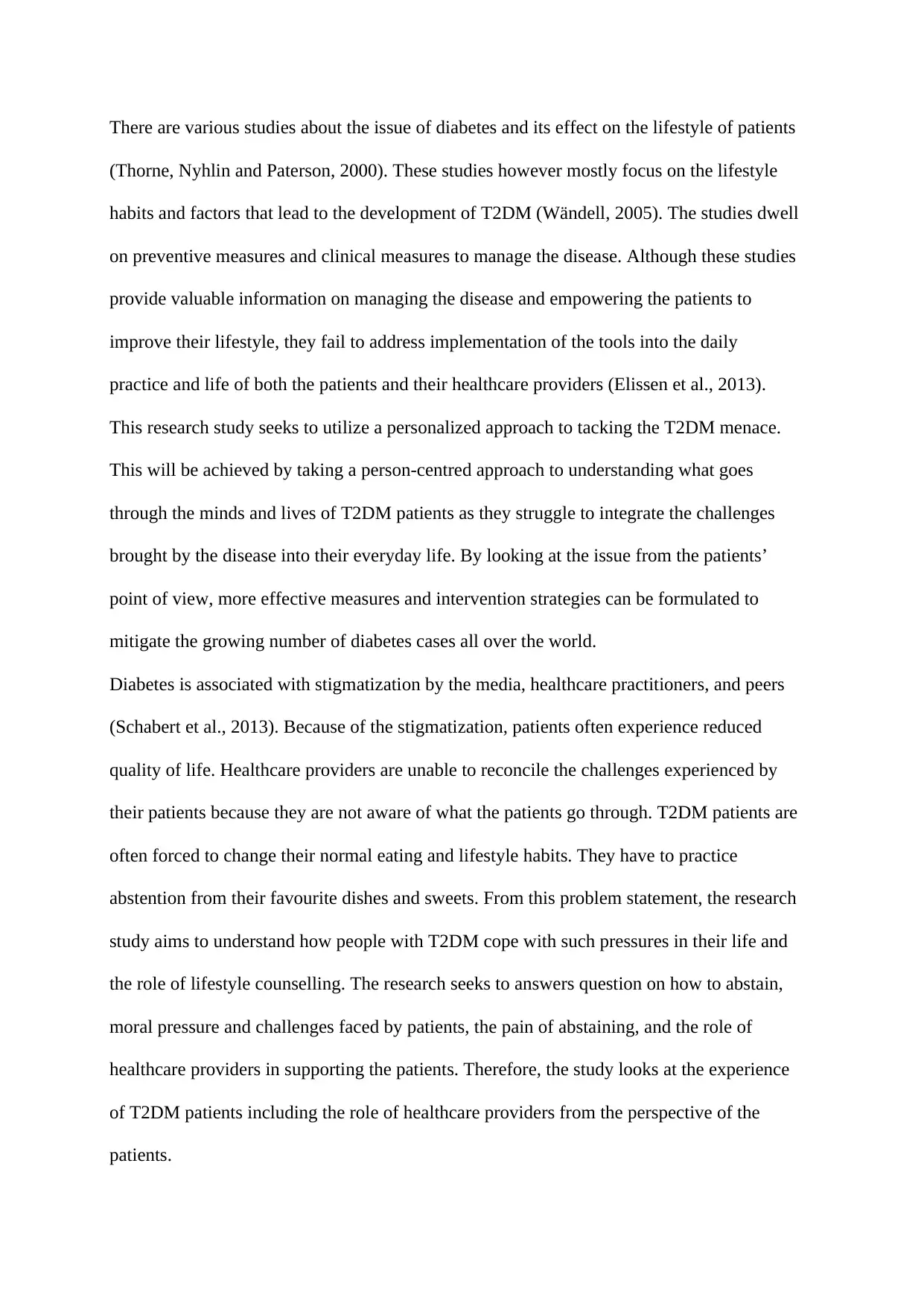
There are various studies about the issue of diabetes and its effect on the lifestyle of patients
(Thorne, Nyhlin and Paterson, 2000). These studies however mostly focus on the lifestyle
habits and factors that lead to the development of T2DM (Wändell, 2005). The studies dwell
on preventive measures and clinical measures to manage the disease. Although these studies
provide valuable information on managing the disease and empowering the patients to
improve their lifestyle, they fail to address implementation of the tools into the daily
practice and life of both the patients and their healthcare providers (Elissen et al., 2013).
This research study seeks to utilize a personalized approach to tacking the T2DM menace.
This will be achieved by taking a person-centred approach to understanding what goes
through the minds and lives of T2DM patients as they struggle to integrate the challenges
brought by the disease into their everyday life. By looking at the issue from the patients’
point of view, more effective measures and intervention strategies can be formulated to
mitigate the growing number of diabetes cases all over the world.
Diabetes is associated with stigmatization by the media, healthcare practitioners, and peers
(Schabert et al., 2013). Because of the stigmatization, patients often experience reduced
quality of life. Healthcare providers are unable to reconcile the challenges experienced by
their patients because they are not aware of what the patients go through. T2DM patients are
often forced to change their normal eating and lifestyle habits. They have to practice
abstention from their favourite dishes and sweets. From this problem statement, the research
study aims to understand how people with T2DM cope with such pressures in their life and
the role of lifestyle counselling. The research seeks to answers question on how to abstain,
moral pressure and challenges faced by patients, the pain of abstaining, and the role of
healthcare providers in supporting the patients. Therefore, the study looks at the experience
of T2DM patients including the role of healthcare providers from the perspective of the
patients.
(Thorne, Nyhlin and Paterson, 2000). These studies however mostly focus on the lifestyle
habits and factors that lead to the development of T2DM (Wändell, 2005). The studies dwell
on preventive measures and clinical measures to manage the disease. Although these studies
provide valuable information on managing the disease and empowering the patients to
improve their lifestyle, they fail to address implementation of the tools into the daily
practice and life of both the patients and their healthcare providers (Elissen et al., 2013).
This research study seeks to utilize a personalized approach to tacking the T2DM menace.
This will be achieved by taking a person-centred approach to understanding what goes
through the minds and lives of T2DM patients as they struggle to integrate the challenges
brought by the disease into their everyday life. By looking at the issue from the patients’
point of view, more effective measures and intervention strategies can be formulated to
mitigate the growing number of diabetes cases all over the world.
Diabetes is associated with stigmatization by the media, healthcare practitioners, and peers
(Schabert et al., 2013). Because of the stigmatization, patients often experience reduced
quality of life. Healthcare providers are unable to reconcile the challenges experienced by
their patients because they are not aware of what the patients go through. T2DM patients are
often forced to change their normal eating and lifestyle habits. They have to practice
abstention from their favourite dishes and sweets. From this problem statement, the research
study aims to understand how people with T2DM cope with such pressures in their life and
the role of lifestyle counselling. The research seeks to answers question on how to abstain,
moral pressure and challenges faced by patients, the pain of abstaining, and the role of
healthcare providers in supporting the patients. Therefore, the study looks at the experience
of T2DM patients including the role of healthcare providers from the perspective of the
patients.
⊘ This is a preview!⊘
Do you want full access?
Subscribe today to unlock all pages.

Trusted by 1+ million students worldwide
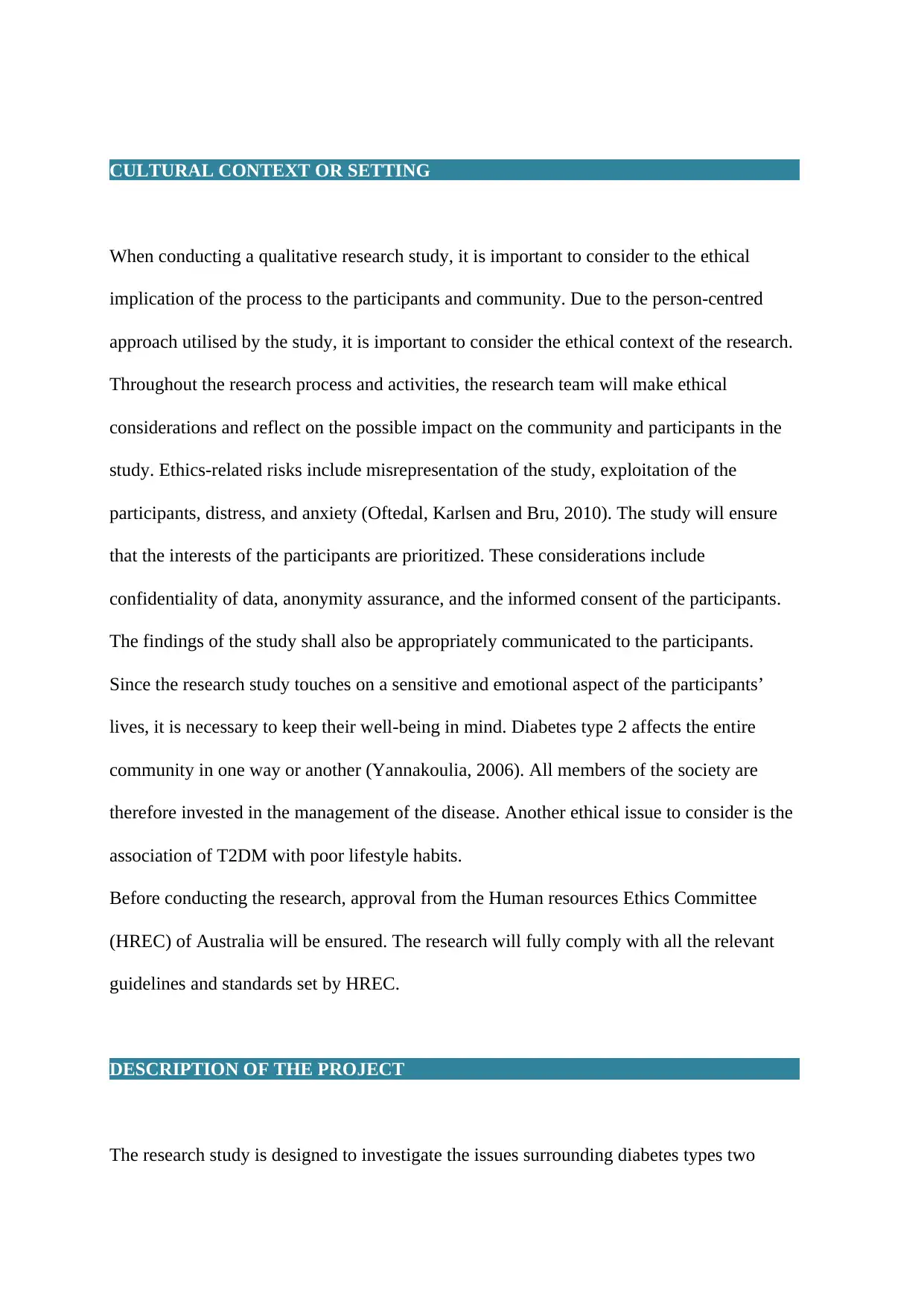
CULTURAL CONTEXT OR SETTING
When conducting a qualitative research study, it is important to consider to the ethical
implication of the process to the participants and community. Due to the person-centred
approach utilised by the study, it is important to consider the ethical context of the research.
Throughout the research process and activities, the research team will make ethical
considerations and reflect on the possible impact on the community and participants in the
study. Ethics-related risks include misrepresentation of the study, exploitation of the
participants, distress, and anxiety (Oftedal, Karlsen and Bru, 2010). The study will ensure
that the interests of the participants are prioritized. These considerations include
confidentiality of data, anonymity assurance, and the informed consent of the participants.
The findings of the study shall also be appropriately communicated to the participants.
Since the research study touches on a sensitive and emotional aspect of the participants’
lives, it is necessary to keep their well-being in mind. Diabetes type 2 affects the entire
community in one way or another (Yannakoulia, 2006). All members of the society are
therefore invested in the management of the disease. Another ethical issue to consider is the
association of T2DM with poor lifestyle habits.
Before conducting the research, approval from the Human resources Ethics Committee
(HREC) of Australia will be ensured. The research will fully comply with all the relevant
guidelines and standards set by HREC.
DESCRIPTION OF THE PROJECT
The research study is designed to investigate the issues surrounding diabetes types two
When conducting a qualitative research study, it is important to consider to the ethical
implication of the process to the participants and community. Due to the person-centred
approach utilised by the study, it is important to consider the ethical context of the research.
Throughout the research process and activities, the research team will make ethical
considerations and reflect on the possible impact on the community and participants in the
study. Ethics-related risks include misrepresentation of the study, exploitation of the
participants, distress, and anxiety (Oftedal, Karlsen and Bru, 2010). The study will ensure
that the interests of the participants are prioritized. These considerations include
confidentiality of data, anonymity assurance, and the informed consent of the participants.
The findings of the study shall also be appropriately communicated to the participants.
Since the research study touches on a sensitive and emotional aspect of the participants’
lives, it is necessary to keep their well-being in mind. Diabetes type 2 affects the entire
community in one way or another (Yannakoulia, 2006). All members of the society are
therefore invested in the management of the disease. Another ethical issue to consider is the
association of T2DM with poor lifestyle habits.
Before conducting the research, approval from the Human resources Ethics Committee
(HREC) of Australia will be ensured. The research will fully comply with all the relevant
guidelines and standards set by HREC.
DESCRIPTION OF THE PROJECT
The research study is designed to investigate the issues surrounding diabetes types two
Paraphrase This Document
Need a fresh take? Get an instant paraphrase of this document with our AI Paraphraser
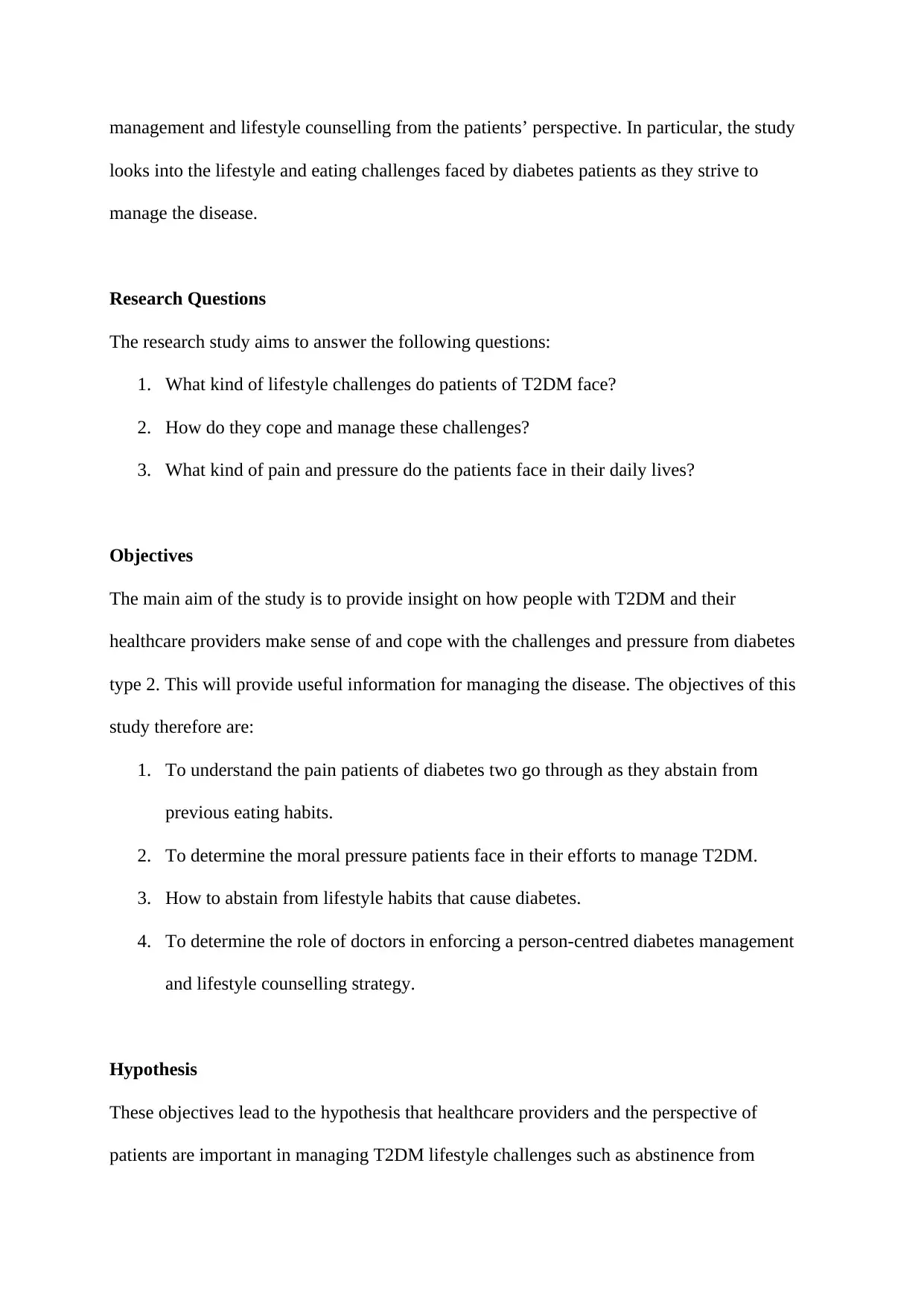
management and lifestyle counselling from the patients’ perspective. In particular, the study
looks into the lifestyle and eating challenges faced by diabetes patients as they strive to
manage the disease.
Research Questions
The research study aims to answer the following questions:
1. What kind of lifestyle challenges do patients of T2DM face?
2. How do they cope and manage these challenges?
3. What kind of pain and pressure do the patients face in their daily lives?
Objectives
The main aim of the study is to provide insight on how people with T2DM and their
healthcare providers make sense of and cope with the challenges and pressure from diabetes
type 2. This will provide useful information for managing the disease. The objectives of this
study therefore are:
1. To understand the pain patients of diabetes two go through as they abstain from
previous eating habits.
2. To determine the moral pressure patients face in their efforts to manage T2DM.
3. How to abstain from lifestyle habits that cause diabetes.
4. To determine the role of doctors in enforcing a person-centred diabetes management
and lifestyle counselling strategy.
Hypothesis
These objectives lead to the hypothesis that healthcare providers and the perspective of
patients are important in managing T2DM lifestyle challenges such as abstinence from
looks into the lifestyle and eating challenges faced by diabetes patients as they strive to
manage the disease.
Research Questions
The research study aims to answer the following questions:
1. What kind of lifestyle challenges do patients of T2DM face?
2. How do they cope and manage these challenges?
3. What kind of pain and pressure do the patients face in their daily lives?
Objectives
The main aim of the study is to provide insight on how people with T2DM and their
healthcare providers make sense of and cope with the challenges and pressure from diabetes
type 2. This will provide useful information for managing the disease. The objectives of this
study therefore are:
1. To understand the pain patients of diabetes two go through as they abstain from
previous eating habits.
2. To determine the moral pressure patients face in their efforts to manage T2DM.
3. How to abstain from lifestyle habits that cause diabetes.
4. To determine the role of doctors in enforcing a person-centred diabetes management
and lifestyle counselling strategy.
Hypothesis
These objectives lead to the hypothesis that healthcare providers and the perspective of
patients are important in managing T2DM lifestyle challenges such as abstinence from
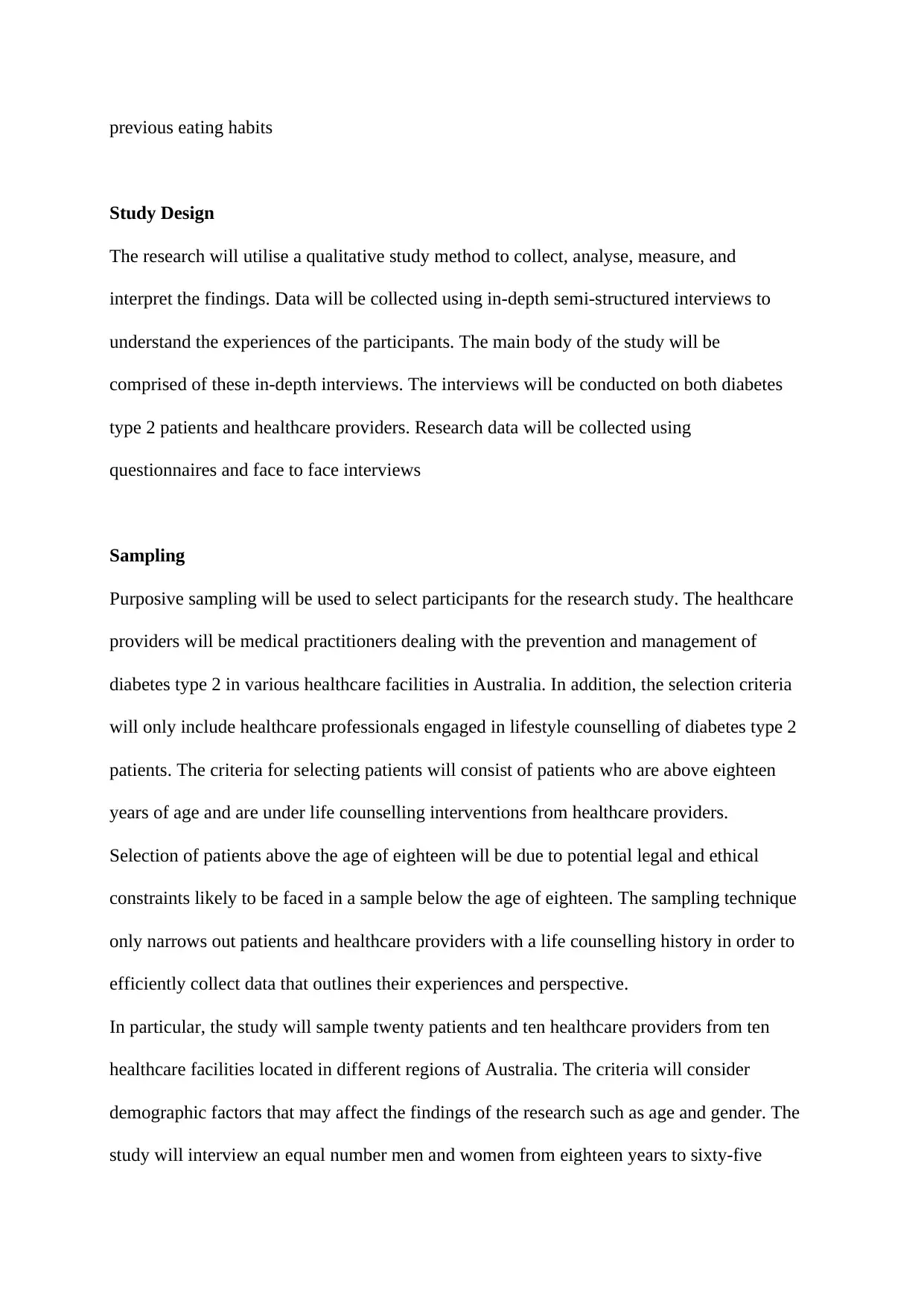
previous eating habits
Study Design
The research will utilise a qualitative study method to collect, analyse, measure, and
interpret the findings. Data will be collected using in-depth semi-structured interviews to
understand the experiences of the participants. The main body of the study will be
comprised of these in-depth interviews. The interviews will be conducted on both diabetes
type 2 patients and healthcare providers. Research data will be collected using
questionnaires and face to face interviews
Sampling
Purposive sampling will be used to select participants for the research study. The healthcare
providers will be medical practitioners dealing with the prevention and management of
diabetes type 2 in various healthcare facilities in Australia. In addition, the selection criteria
will only include healthcare professionals engaged in lifestyle counselling of diabetes type 2
patients. The criteria for selecting patients will consist of patients who are above eighteen
years of age and are under life counselling interventions from healthcare providers.
Selection of patients above the age of eighteen will be due to potential legal and ethical
constraints likely to be faced in a sample below the age of eighteen. The sampling technique
only narrows out patients and healthcare providers with a life counselling history in order to
efficiently collect data that outlines their experiences and perspective.
In particular, the study will sample twenty patients and ten healthcare providers from ten
healthcare facilities located in different regions of Australia. The criteria will consider
demographic factors that may affect the findings of the research such as age and gender. The
study will interview an equal number men and women from eighteen years to sixty-five
Study Design
The research will utilise a qualitative study method to collect, analyse, measure, and
interpret the findings. Data will be collected using in-depth semi-structured interviews to
understand the experiences of the participants. The main body of the study will be
comprised of these in-depth interviews. The interviews will be conducted on both diabetes
type 2 patients and healthcare providers. Research data will be collected using
questionnaires and face to face interviews
Sampling
Purposive sampling will be used to select participants for the research study. The healthcare
providers will be medical practitioners dealing with the prevention and management of
diabetes type 2 in various healthcare facilities in Australia. In addition, the selection criteria
will only include healthcare professionals engaged in lifestyle counselling of diabetes type 2
patients. The criteria for selecting patients will consist of patients who are above eighteen
years of age and are under life counselling interventions from healthcare providers.
Selection of patients above the age of eighteen will be due to potential legal and ethical
constraints likely to be faced in a sample below the age of eighteen. The sampling technique
only narrows out patients and healthcare providers with a life counselling history in order to
efficiently collect data that outlines their experiences and perspective.
In particular, the study will sample twenty patients and ten healthcare providers from ten
healthcare facilities located in different regions of Australia. The criteria will consider
demographic factors that may affect the findings of the research such as age and gender. The
study will interview an equal number men and women from eighteen years to sixty-five
⊘ This is a preview!⊘
Do you want full access?
Subscribe today to unlock all pages.

Trusted by 1+ million students worldwide
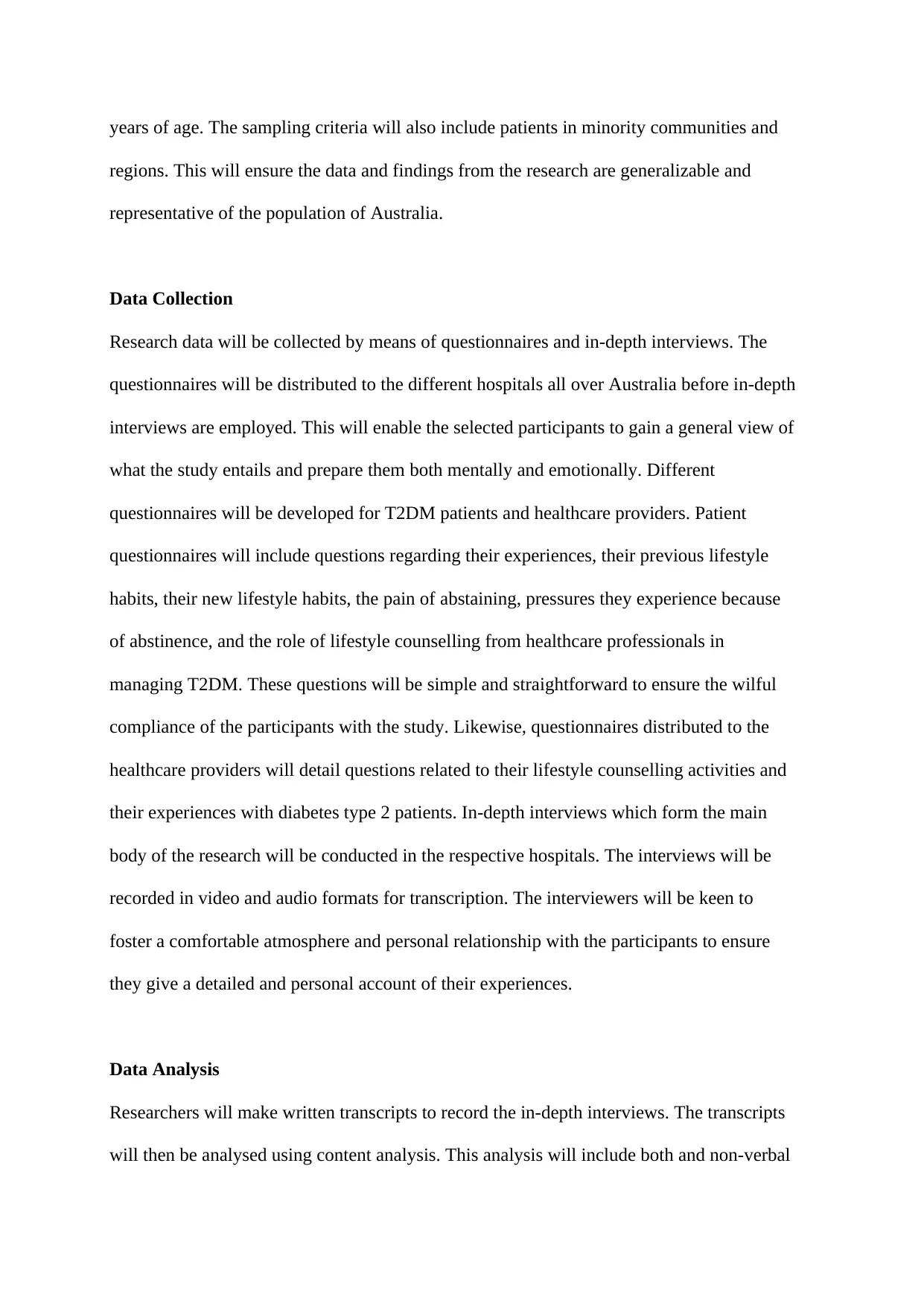
years of age. The sampling criteria will also include patients in minority communities and
regions. This will ensure the data and findings from the research are generalizable and
representative of the population of Australia.
Data Collection
Research data will be collected by means of questionnaires and in-depth interviews. The
questionnaires will be distributed to the different hospitals all over Australia before in-depth
interviews are employed. This will enable the selected participants to gain a general view of
what the study entails and prepare them both mentally and emotionally. Different
questionnaires will be developed for T2DM patients and healthcare providers. Patient
questionnaires will include questions regarding their experiences, their previous lifestyle
habits, their new lifestyle habits, the pain of abstaining, pressures they experience because
of abstinence, and the role of lifestyle counselling from healthcare professionals in
managing T2DM. These questions will be simple and straightforward to ensure the wilful
compliance of the participants with the study. Likewise, questionnaires distributed to the
healthcare providers will detail questions related to their lifestyle counselling activities and
their experiences with diabetes type 2 patients. In-depth interviews which form the main
body of the research will be conducted in the respective hospitals. The interviews will be
recorded in video and audio formats for transcription. The interviewers will be keen to
foster a comfortable atmosphere and personal relationship with the participants to ensure
they give a detailed and personal account of their experiences.
Data Analysis
Researchers will make written transcripts to record the in-depth interviews. The transcripts
will then be analysed using content analysis. This analysis will include both and non-verbal
regions. This will ensure the data and findings from the research are generalizable and
representative of the population of Australia.
Data Collection
Research data will be collected by means of questionnaires and in-depth interviews. The
questionnaires will be distributed to the different hospitals all over Australia before in-depth
interviews are employed. This will enable the selected participants to gain a general view of
what the study entails and prepare them both mentally and emotionally. Different
questionnaires will be developed for T2DM patients and healthcare providers. Patient
questionnaires will include questions regarding their experiences, their previous lifestyle
habits, their new lifestyle habits, the pain of abstaining, pressures they experience because
of abstinence, and the role of lifestyle counselling from healthcare professionals in
managing T2DM. These questions will be simple and straightforward to ensure the wilful
compliance of the participants with the study. Likewise, questionnaires distributed to the
healthcare providers will detail questions related to their lifestyle counselling activities and
their experiences with diabetes type 2 patients. In-depth interviews which form the main
body of the research will be conducted in the respective hospitals. The interviews will be
recorded in video and audio formats for transcription. The interviewers will be keen to
foster a comfortable atmosphere and personal relationship with the participants to ensure
they give a detailed and personal account of their experiences.
Data Analysis
Researchers will make written transcripts to record the in-depth interviews. The transcripts
will then be analysed using content analysis. This analysis will include both and non-verbal
Paraphrase This Document
Need a fresh take? Get an instant paraphrase of this document with our AI Paraphraser
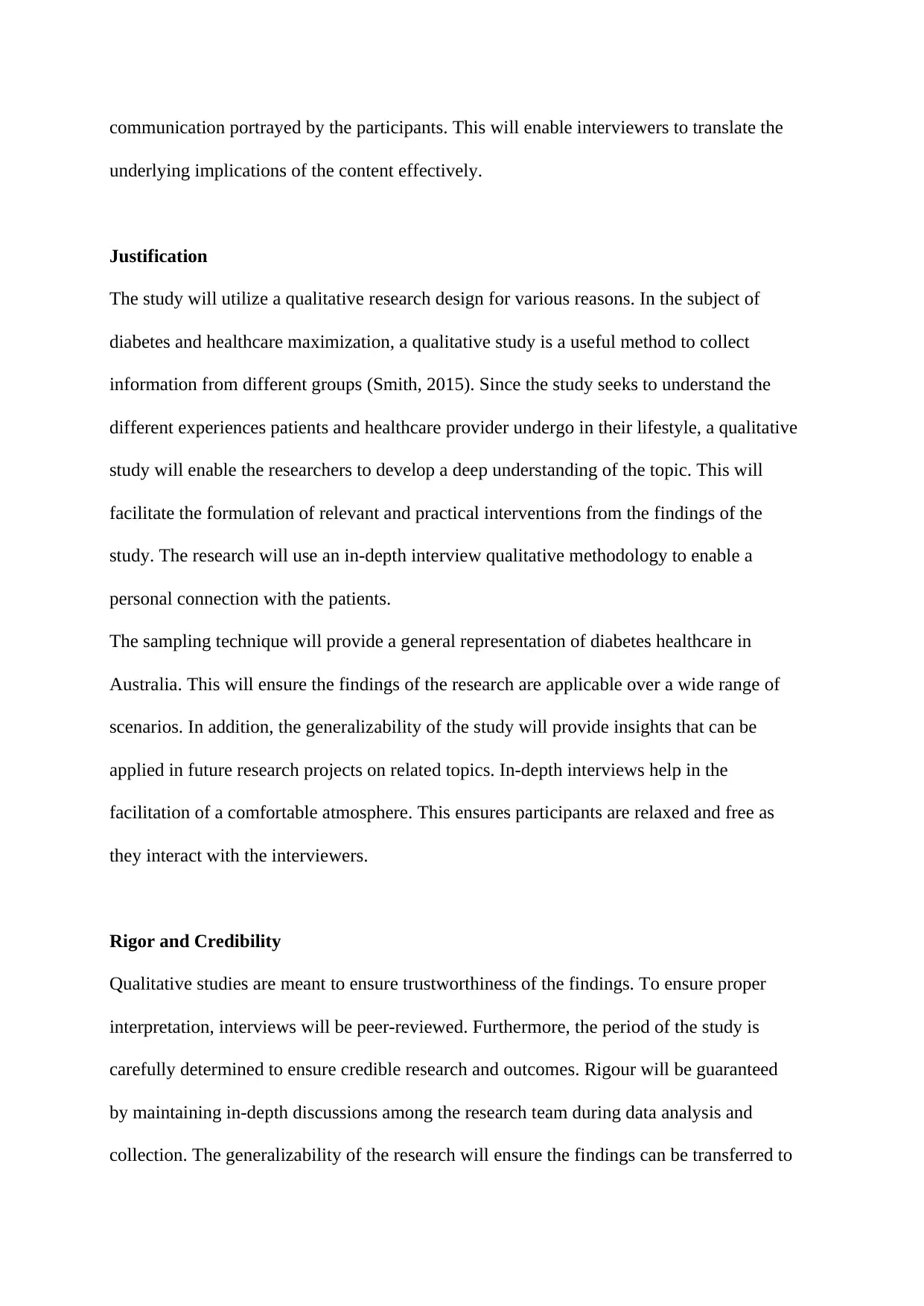
communication portrayed by the participants. This will enable interviewers to translate the
underlying implications of the content effectively.
Justification
The study will utilize a qualitative research design for various reasons. In the subject of
diabetes and healthcare maximization, a qualitative study is a useful method to collect
information from different groups (Smith, 2015). Since the study seeks to understand the
different experiences patients and healthcare provider undergo in their lifestyle, a qualitative
study will enable the researchers to develop a deep understanding of the topic. This will
facilitate the formulation of relevant and practical interventions from the findings of the
study. The research will use an in-depth interview qualitative methodology to enable a
personal connection with the patients.
The sampling technique will provide a general representation of diabetes healthcare in
Australia. This will ensure the findings of the research are applicable over a wide range of
scenarios. In addition, the generalizability of the study will provide insights that can be
applied in future research projects on related topics. In-depth interviews help in the
facilitation of a comfortable atmosphere. This ensures participants are relaxed and free as
they interact with the interviewers.
Rigor and Credibility
Qualitative studies are meant to ensure trustworthiness of the findings. To ensure proper
interpretation, interviews will be peer-reviewed. Furthermore, the period of the study is
carefully determined to ensure credible research and outcomes. Rigour will be guaranteed
by maintaining in-depth discussions among the research team during data analysis and
collection. The generalizability of the research will ensure the findings can be transferred to
underlying implications of the content effectively.
Justification
The study will utilize a qualitative research design for various reasons. In the subject of
diabetes and healthcare maximization, a qualitative study is a useful method to collect
information from different groups (Smith, 2015). Since the study seeks to understand the
different experiences patients and healthcare provider undergo in their lifestyle, a qualitative
study will enable the researchers to develop a deep understanding of the topic. This will
facilitate the formulation of relevant and practical interventions from the findings of the
study. The research will use an in-depth interview qualitative methodology to enable a
personal connection with the patients.
The sampling technique will provide a general representation of diabetes healthcare in
Australia. This will ensure the findings of the research are applicable over a wide range of
scenarios. In addition, the generalizability of the study will provide insights that can be
applied in future research projects on related topics. In-depth interviews help in the
facilitation of a comfortable atmosphere. This ensures participants are relaxed and free as
they interact with the interviewers.
Rigor and Credibility
Qualitative studies are meant to ensure trustworthiness of the findings. To ensure proper
interpretation, interviews will be peer-reviewed. Furthermore, the period of the study is
carefully determined to ensure credible research and outcomes. Rigour will be guaranteed
by maintaining in-depth discussions among the research team during data analysis and
collection. The generalizability of the research will ensure the findings can be transferred to
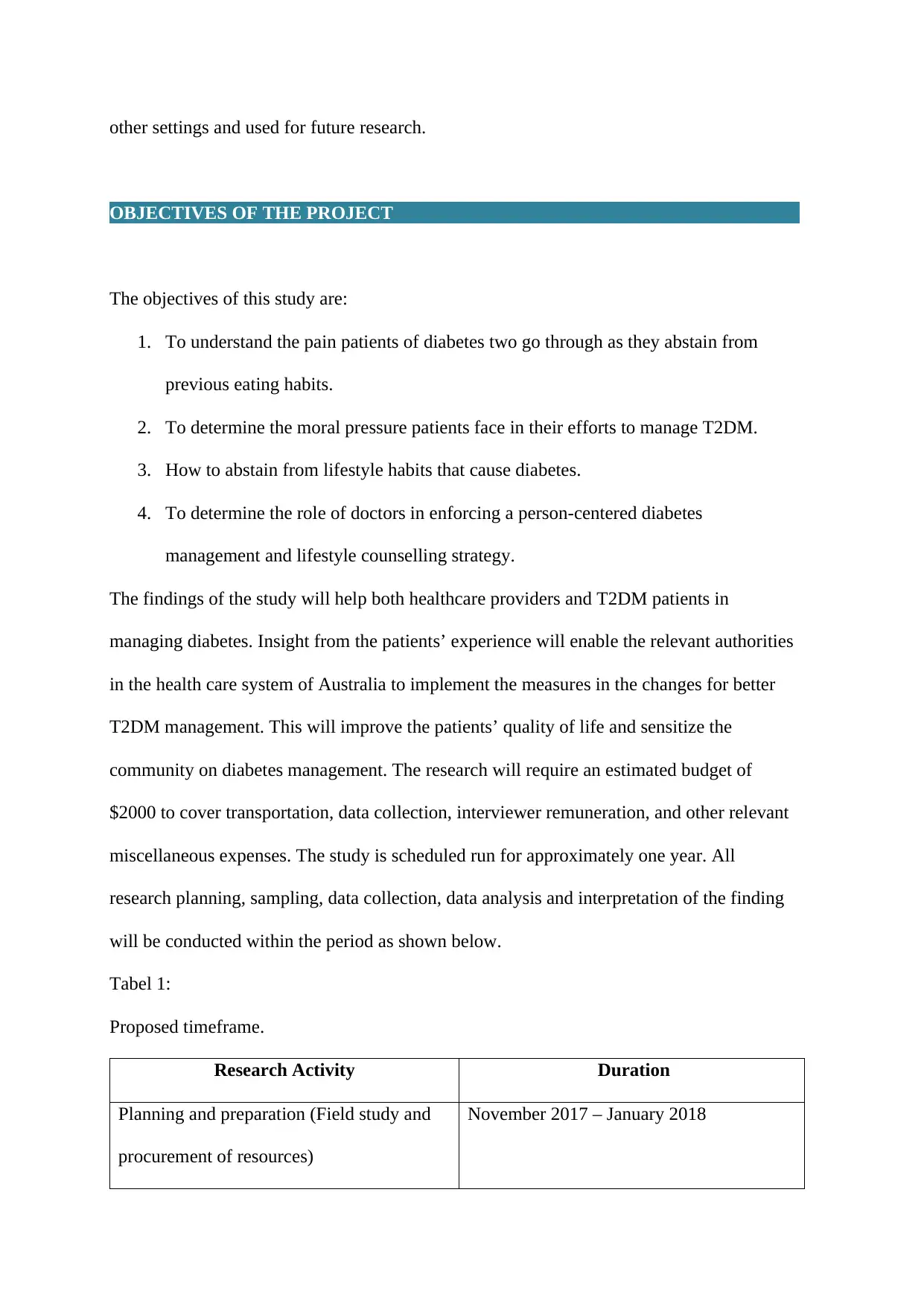
other settings and used for future research.
OBJECTIVES OF THE PROJECT
The objectives of this study are:
1. To understand the pain patients of diabetes two go through as they abstain from
previous eating habits.
2. To determine the moral pressure patients face in their efforts to manage T2DM.
3. How to abstain from lifestyle habits that cause diabetes.
4. To determine the role of doctors in enforcing a person-centered diabetes
management and lifestyle counselling strategy.
The findings of the study will help both healthcare providers and T2DM patients in
managing diabetes. Insight from the patients’ experience will enable the relevant authorities
in the health care system of Australia to implement the measures in the changes for better
T2DM management. This will improve the patients’ quality of life and sensitize the
community on diabetes management. The research will require an estimated budget of
$2000 to cover transportation, data collection, interviewer remuneration, and other relevant
miscellaneous expenses. The study is scheduled run for approximately one year. All
research planning, sampling, data collection, data analysis and interpretation of the finding
will be conducted within the period as shown below.
Tabel 1:
Proposed timeframe.
Research Activity Duration
Planning and preparation (Field study and
procurement of resources)
November 2017 – January 2018
OBJECTIVES OF THE PROJECT
The objectives of this study are:
1. To understand the pain patients of diabetes two go through as they abstain from
previous eating habits.
2. To determine the moral pressure patients face in their efforts to manage T2DM.
3. How to abstain from lifestyle habits that cause diabetes.
4. To determine the role of doctors in enforcing a person-centered diabetes
management and lifestyle counselling strategy.
The findings of the study will help both healthcare providers and T2DM patients in
managing diabetes. Insight from the patients’ experience will enable the relevant authorities
in the health care system of Australia to implement the measures in the changes for better
T2DM management. This will improve the patients’ quality of life and sensitize the
community on diabetes management. The research will require an estimated budget of
$2000 to cover transportation, data collection, interviewer remuneration, and other relevant
miscellaneous expenses. The study is scheduled run for approximately one year. All
research planning, sampling, data collection, data analysis and interpretation of the finding
will be conducted within the period as shown below.
Tabel 1:
Proposed timeframe.
Research Activity Duration
Planning and preparation (Field study and
procurement of resources)
November 2017 – January 2018
⊘ This is a preview!⊘
Do you want full access?
Subscribe today to unlock all pages.

Trusted by 1+ million students worldwide

Sampling January 2018 – February 2018
Distribution of Questionnaires April 2018 – May 2018
In-depth Interviews May 2018- August 2018
Data analysis September 2018- October 2018
Final Report November 2018
Distribution of Questionnaires April 2018 – May 2018
In-depth Interviews May 2018- August 2018
Data analysis September 2018- October 2018
Final Report November 2018
Paraphrase This Document
Need a fresh take? Get an instant paraphrase of this document with our AI Paraphraser
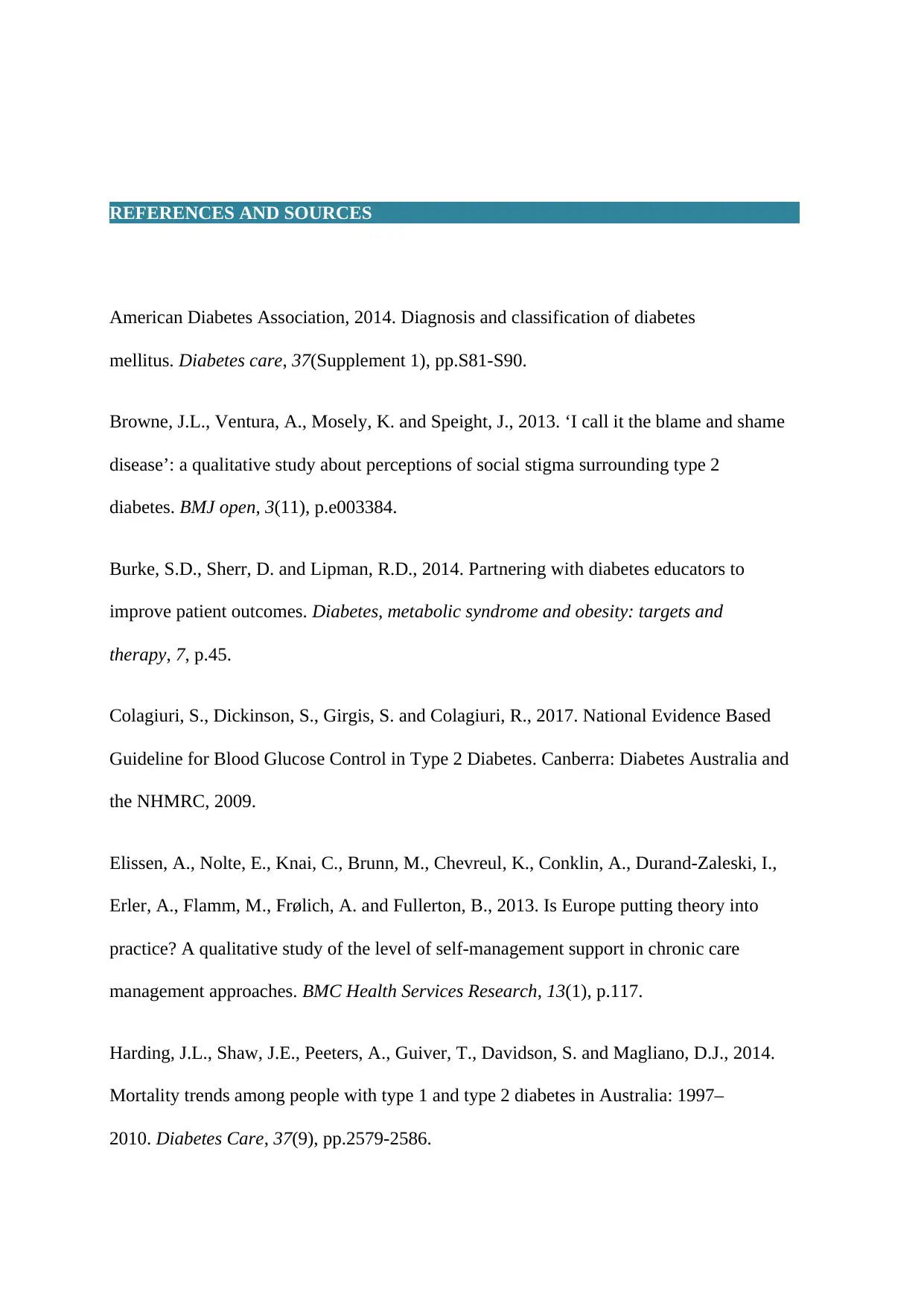
REFERENCES AND SOURCES
American Diabetes Association, 2014. Diagnosis and classification of diabetes
mellitus. Diabetes care, 37(Supplement 1), pp.S81-S90.
Browne, J.L., Ventura, A., Mosely, K. and Speight, J., 2013. ‘I call it the blame and shame
disease’: a qualitative study about perceptions of social stigma surrounding type 2
diabetes. BMJ open, 3(11), p.e003384.
Burke, S.D., Sherr, D. and Lipman, R.D., 2014. Partnering with diabetes educators to
improve patient outcomes. Diabetes, metabolic syndrome and obesity: targets and
therapy, 7, p.45.
Colagiuri, S., Dickinson, S., Girgis, S. and Colagiuri, R., 2017. National Evidence Based
Guideline for Blood Glucose Control in Type 2 Diabetes. Canberra: Diabetes Australia and
the NHMRC, 2009.
Elissen, A., Nolte, E., Knai, C., Brunn, M., Chevreul, K., Conklin, A., Durand-Zaleski, I.,
Erler, A., Flamm, M., Frølich, A. and Fullerton, B., 2013. Is Europe putting theory into
practice? A qualitative study of the level of self-management support in chronic care
management approaches. BMC Health Services Research, 13(1), p.117.
Harding, J.L., Shaw, J.E., Peeters, A., Guiver, T., Davidson, S. and Magliano, D.J., 2014.
Mortality trends among people with type 1 and type 2 diabetes in Australia: 1997–
2010. Diabetes Care, 37(9), pp.2579-2586.
American Diabetes Association, 2014. Diagnosis and classification of diabetes
mellitus. Diabetes care, 37(Supplement 1), pp.S81-S90.
Browne, J.L., Ventura, A., Mosely, K. and Speight, J., 2013. ‘I call it the blame and shame
disease’: a qualitative study about perceptions of social stigma surrounding type 2
diabetes. BMJ open, 3(11), p.e003384.
Burke, S.D., Sherr, D. and Lipman, R.D., 2014. Partnering with diabetes educators to
improve patient outcomes. Diabetes, metabolic syndrome and obesity: targets and
therapy, 7, p.45.
Colagiuri, S., Dickinson, S., Girgis, S. and Colagiuri, R., 2017. National Evidence Based
Guideline for Blood Glucose Control in Type 2 Diabetes. Canberra: Diabetes Australia and
the NHMRC, 2009.
Elissen, A., Nolte, E., Knai, C., Brunn, M., Chevreul, K., Conklin, A., Durand-Zaleski, I.,
Erler, A., Flamm, M., Frølich, A. and Fullerton, B., 2013. Is Europe putting theory into
practice? A qualitative study of the level of self-management support in chronic care
management approaches. BMC Health Services Research, 13(1), p.117.
Harding, J.L., Shaw, J.E., Peeters, A., Guiver, T., Davidson, S. and Magliano, D.J., 2014.
Mortality trends among people with type 1 and type 2 diabetes in Australia: 1997–
2010. Diabetes Care, 37(9), pp.2579-2586.
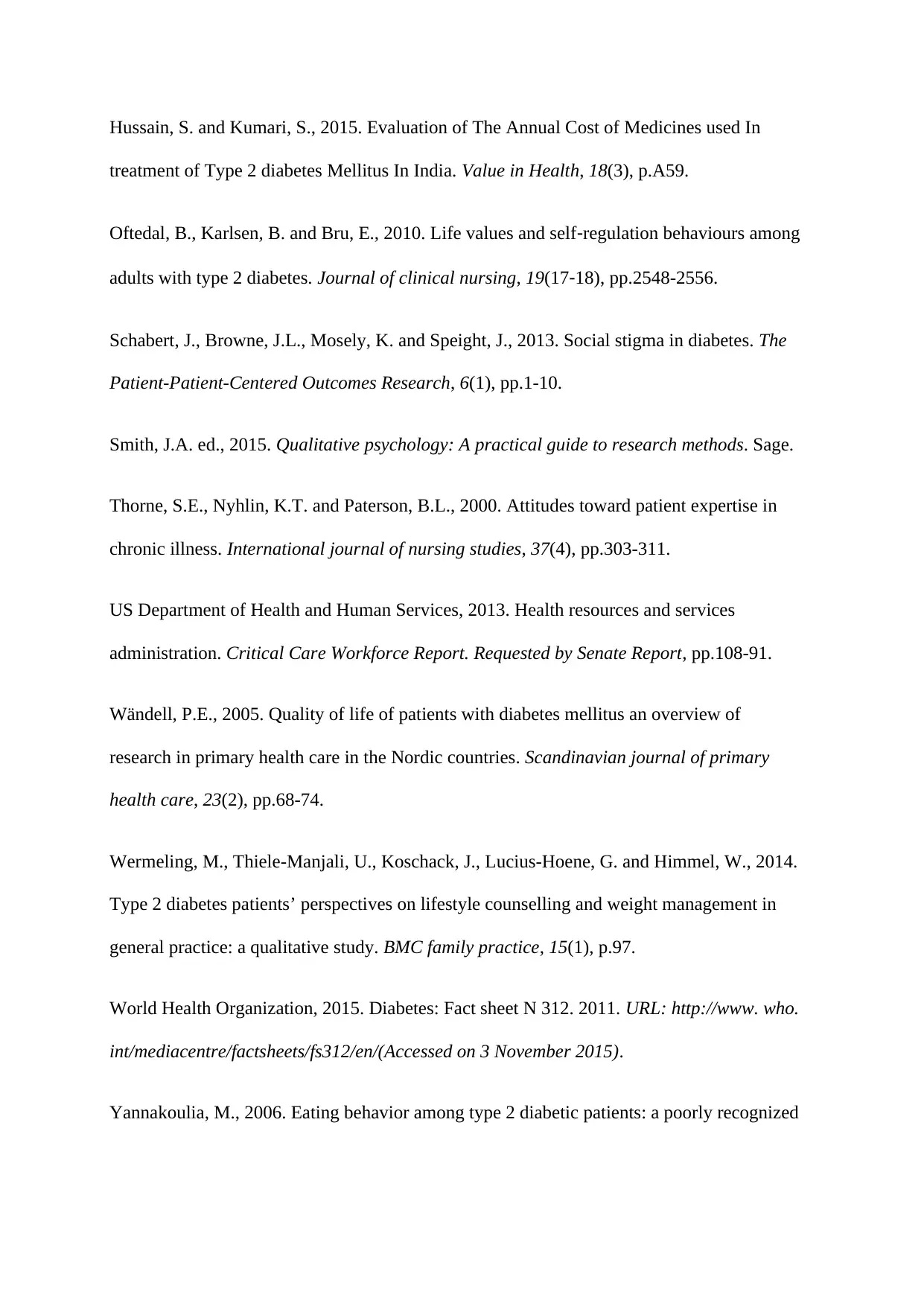
Hussain, S. and Kumari, S., 2015. Evaluation of The Annual Cost of Medicines used In
treatment of Type 2 diabetes Mellitus In India. Value in Health, 18(3), p.A59.
Oftedal, B., Karlsen, B. and Bru, E., 2010. Life values and self‐regulation behaviours among
adults with type 2 diabetes. Journal of clinical nursing, 19(17‐18), pp.2548-2556.
Schabert, J., Browne, J.L., Mosely, K. and Speight, J., 2013. Social stigma in diabetes. The
Patient-Patient-Centered Outcomes Research, 6(1), pp.1-10.
Smith, J.A. ed., 2015. Qualitative psychology: A practical guide to research methods. Sage.
Thorne, S.E., Nyhlin, K.T. and Paterson, B.L., 2000. Attitudes toward patient expertise in
chronic illness. International journal of nursing studies, 37(4), pp.303-311.
US Department of Health and Human Services, 2013. Health resources and services
administration. Critical Care Workforce Report. Requested by Senate Report, pp.108-91.
Wändell, P.E., 2005. Quality of life of patients with diabetes mellitus an overview of
research in primary health care in the Nordic countries. Scandinavian journal of primary
health care, 23(2), pp.68-74.
Wermeling, M., Thiele-Manjali, U., Koschack, J., Lucius-Hoene, G. and Himmel, W., 2014.
Type 2 diabetes patients’ perspectives on lifestyle counselling and weight management in
general practice: a qualitative study. BMC family practice, 15(1), p.97.
World Health Organization, 2015. Diabetes: Fact sheet N 312. 2011. URL: http://www. who.
int/mediacentre/factsheets/fs312/en/(Accessed on 3 November 2015).
Yannakoulia, M., 2006. Eating behavior among type 2 diabetic patients: a poorly recognized
treatment of Type 2 diabetes Mellitus In India. Value in Health, 18(3), p.A59.
Oftedal, B., Karlsen, B. and Bru, E., 2010. Life values and self‐regulation behaviours among
adults with type 2 diabetes. Journal of clinical nursing, 19(17‐18), pp.2548-2556.
Schabert, J., Browne, J.L., Mosely, K. and Speight, J., 2013. Social stigma in diabetes. The
Patient-Patient-Centered Outcomes Research, 6(1), pp.1-10.
Smith, J.A. ed., 2015. Qualitative psychology: A practical guide to research methods. Sage.
Thorne, S.E., Nyhlin, K.T. and Paterson, B.L., 2000. Attitudes toward patient expertise in
chronic illness. International journal of nursing studies, 37(4), pp.303-311.
US Department of Health and Human Services, 2013. Health resources and services
administration. Critical Care Workforce Report. Requested by Senate Report, pp.108-91.
Wändell, P.E., 2005. Quality of life of patients with diabetes mellitus an overview of
research in primary health care in the Nordic countries. Scandinavian journal of primary
health care, 23(2), pp.68-74.
Wermeling, M., Thiele-Manjali, U., Koschack, J., Lucius-Hoene, G. and Himmel, W., 2014.
Type 2 diabetes patients’ perspectives on lifestyle counselling and weight management in
general practice: a qualitative study. BMC family practice, 15(1), p.97.
World Health Organization, 2015. Diabetes: Fact sheet N 312. 2011. URL: http://www. who.
int/mediacentre/factsheets/fs312/en/(Accessed on 3 November 2015).
Yannakoulia, M., 2006. Eating behavior among type 2 diabetic patients: a poorly recognized
⊘ This is a preview!⊘
Do you want full access?
Subscribe today to unlock all pages.

Trusted by 1+ million students worldwide
1 out of 12
Related Documents
Your All-in-One AI-Powered Toolkit for Academic Success.
+13062052269
info@desklib.com
Available 24*7 on WhatsApp / Email
![[object Object]](/_next/static/media/star-bottom.7253800d.svg)
Unlock your academic potential
Copyright © 2020–2025 A2Z Services. All Rights Reserved. Developed and managed by ZUCOL.





